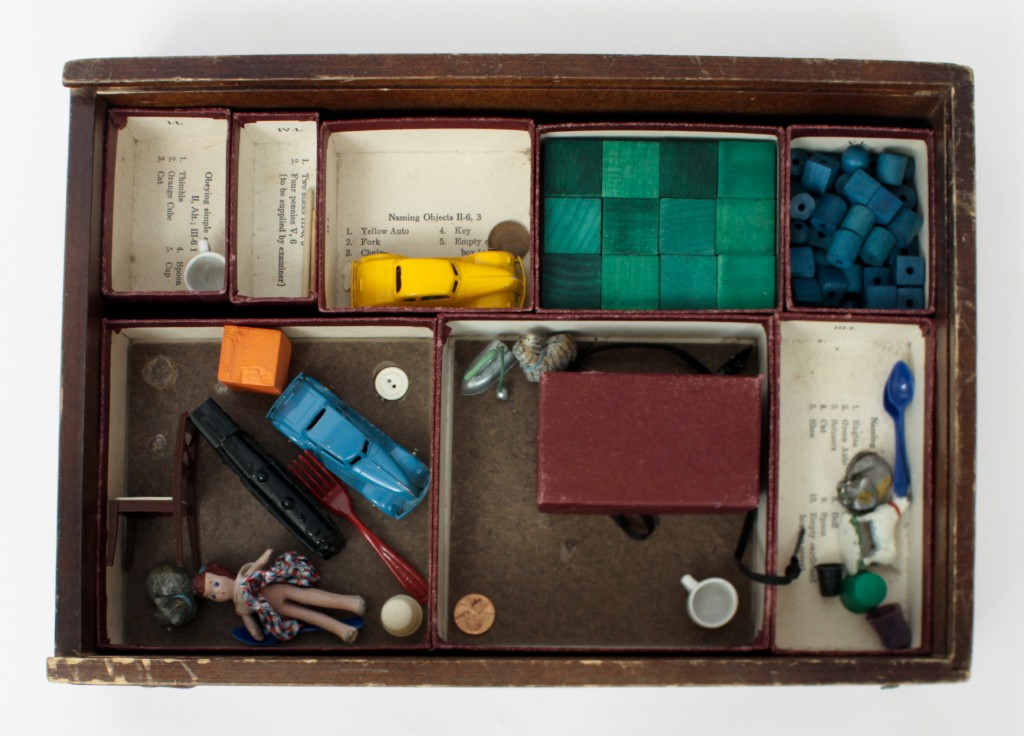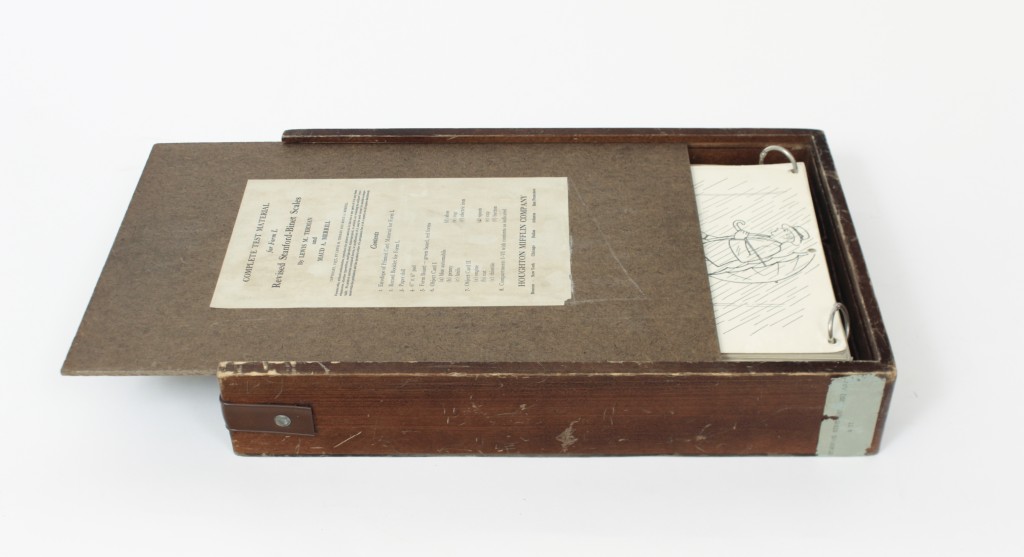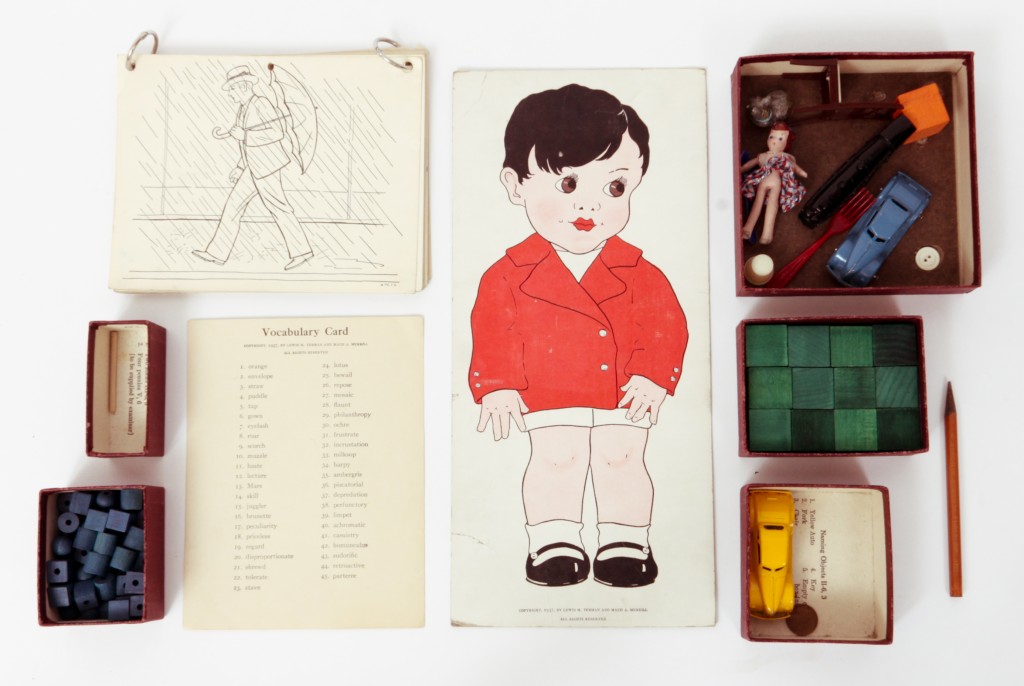 “Complete Test Material for Revised Stanford-Binet Scales (Form L)”, 1937, 2013.psy.141
“Complete Test Material for Revised Stanford-Binet Scales (Form L)”, 1937, 2013.psy.141
In the U of T Department of Psychology’s vast psychology collection, there is one test that is more numerous and prominent than any other: the Stanford-Binet Intelligence Scale. This test was, and still is, used to provide neuropsychological assessments, assist in educational planning and placement, and contribute to psychological and psychiatric research. The test was first designed in 1905 by Alfred Binet (1857-1911), a French psychologist, and his student Theodore Simon (1872-1961). It was originally known as the Binet-Simon Intelligence Scale. The original purpose of the test was to allow psychologists to detect and diagnose developmental or intellectual deficiencies in young children.
The revision of the test in 1916, renamed the Stanford-Binet Intelligence Scale, was developed by Lewis M. Terman of Stanford University. This revision now allowed for the identification of both children and adults with above average intelligence. The Stanford-Binet Intelligence Scale reflects the development of one of psychology’s greatest successes, that being standardized intelligence testing. The development of the Stanford-Binet Scale was also instrumental in initiating modern-day intelligence testing techniques. It was one of the earliest “adaptive tests”, meaning that its design allowed for each candidate to experience a version of the test that matched their ability level.
The widespread acceptance of this test meant that it has been used extensively by professors and researchers at the University of Toronto. The Stanford-Binet has been implemented at UofT in various studies, from determining the difference between “bright and dull children”, to comparing a child’s school achievement based on their family background. Most notably, it used was by university psychiatrists in the 1940s, under the direction of Dr. Clarence B. Farrar (1874-1970), to test and treat patients with schizophrenia.
Collection: University of Toronto Scientific Instruments Collection (2013.psy.141)
Maker: Houghton Mifflin Company, (Boston, Mass.), produced in 1937
Dimensions: Height = 7.5 cm; Width = 26 cm; Depth = 38.5 cm
Materials: Primary materials include wood, paper, plastic, metal, cardboard
Background
The Stanford-Binet Intelligence Scale primarily belongs to the scientific field of psychology and is categorized as a standardized intelligence test. Standardized intelligence tests are one of the field’s most long-lasting and widely used innovations, namely the use of a battery of various tests to determine an individual’s intellectual potential. The Stanford-Binet does this through testing five weighted factors, both verbally and nonverbally, including knowledge, quantitative reasoning, visual-spatial processing, working memory, and fluid reasoning. This allows psychologists to have a uniform way in which to compare a person’s performance with that of others in a similar age group.
The test was first designed in 1905 by Alfred Binet and Theodore Simon, known as the Binet-Simon Intelligence Scale. This test was developed after the French government passed a law mandating universal education. Binet’s goal was to use this test to identify children with learning, intellectual or developmental disabilities. The Binet-Simon could allow psychologists to quickly determine which of these children were better suited for special education programs rather than asylums. The popularity of the Binet-Simon Test led Lewis M. Terman (1877-1956), a psychologist at Stanford University, to create an updated version in 1916 for American citizens. This revision, known as the Stanford-Binet Intelligence Scale, not only identified learning difficulties in children, but could identify both children and adults with above average levels of intelligence. Since 1916 the Stanford-Binet Intelligence Scale has undergone four revisions, with the latest occurring in 2003. These revisions have been initiated by leading psychologists, including Maud Merrill (1888-1978), Robert Thorndike (1910-1990), and Gale Roid.
As a standardized intelligence test, the Stanford-Binet does have its fair share of criticisms. It has been accused of unfairly dividing test-takers by race, gender, class and culture. As well, some critics argue that it minimizes the importance of creativity and character. This minimization, it is argued, propagates the belief that individuals are born with an unchangeable intellectual potential that will determine all future success. However, the Stanford-Binet was, and continues to be, one of the most popular psychological tests in existence. It was used by the United States government at the start of World War I, with over 1.7 million recruits taking a version of the test to be approved for service. It also continues to be used by several educational institutions as part of their admissions process, particularly in identifying gifted children.
The most interesting use of the Stanford-Binet Intelligence Scale at the University of Toronto occurred in the 1940s when it was used to test and treat patients with schizophrenia. This project was undertaken by Dr. Clarence B. Farrar, the head of U of T’s Psychiatry Department from 1926-1947, and the first Director of the Toronto Psychiatric Hospital. In the 1940s, schizophrenia was still a widely misunderstood and understudied disease, and Dr. Farrar’s work was at the forefront of early research regarding schizophrenia. Dr. Farrar, and his fellow professors, were determined to investigate possible causes of, and treatments for, schizophrenia. In 1937, the Austrian psychiatrist Manfred Sakel published his findings that the majority of schizophrenic patients, when treated with insulin shock therapies, showed some degree of improvement or recovered completely.
From 1941-48, Dr. Farrar’s team was conducting insulin shock therapy treatments on schizophrenic patients. Following the treatments, the patients were subjected to a battery of psychometric tests, including the Stanford-Binet Intelligence Scale, to determine if any improvements had been made. It appears that researchers at the University of Toronto came to a much different conclusion regarding the success of insulin shock therapy than did Manfred Sakel. In his personal notes, Dr. Farrar wrote, “our conclusion is that insulin does not have a specific curative effect, but that it may bring about changes that accelerate or facilitate improvement in those who [have the] capacity for such improvement or recovery” Although the Psychiatry Department at the University of Toronto was unable to determine a cure for schizophrenia, they did carry out long-term research on a mental illness that had long been neglected by the medical community. These psychiatrists were successful in their endeavors because they eliminated the notion that insulin shock therapy could cure schizophrenia, allowing further researchers to focus on studying other treatments.
Form and Fabrication
This object was made by Houghton Mifflin Harcourt in 1937, an educational publisher in Boston, Massachusetts. It is the second edition of the Stanford-Binet Intelligence Scale, developed by Lewis M. Terman and Maud Merrill. This artefact consists of a wooden box, containing both printed materials and small wooden or plastic objects for testing intelligence in children.
The printed materials inside the wooden box include a vocabulary card and a booklet of verbal and picture exercises. This booklet includes illustrated scenes, word problems, sentences with scrambled words, illustrations of animals and objects, and one large illustrated colour image of a young boy. There are also three envelopes that contain multiple testing cards. The wooden and plastic testing materials are divided into eight variously sized cardboard boxes. These objects include:
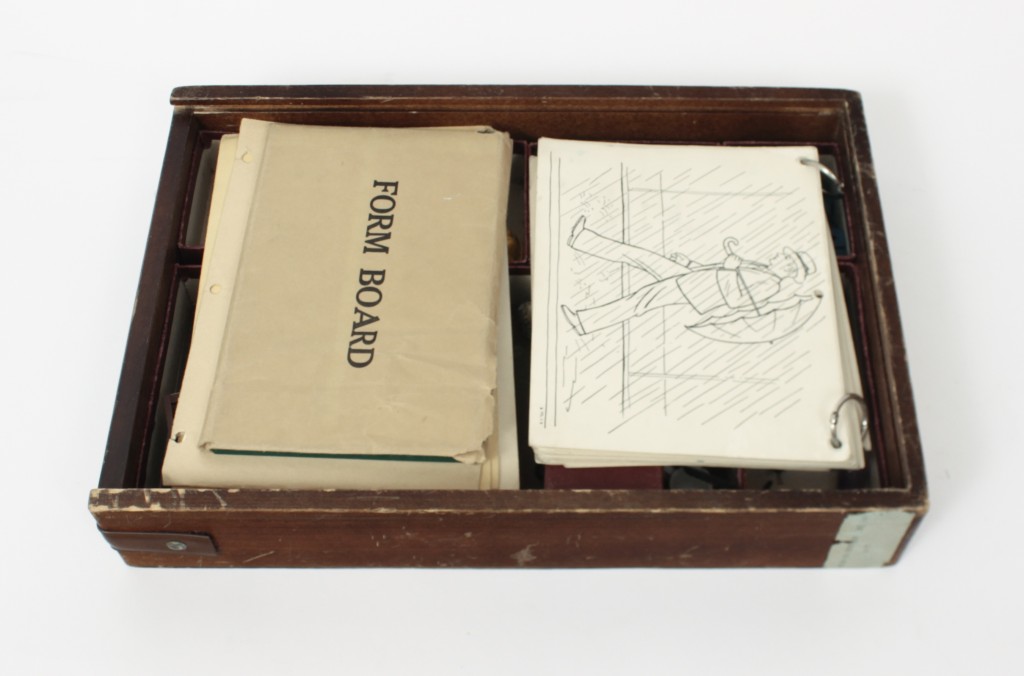 a wooden “Form Board”
a wooden “Form Board”- a plastic button
- three thimbles
- a plastic toy train car
- a plastic chair
- two tin toy automobiles
- two sets of plastic miniature spoons and forks
- two ceramic miniature teacups
- a plastic miniature chair
- a set of wooden blocks
- two ceramic cats and one ceramic dog
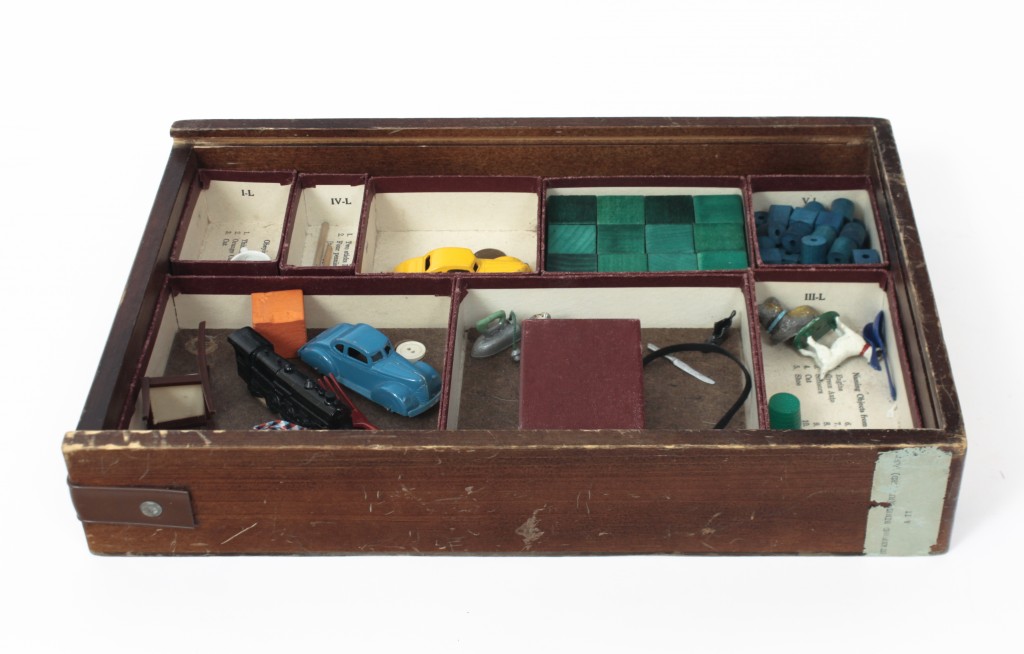 a rubber doll.
a rubber doll.
There are few signs of any deterioration or damage. It is in relatively good condition apart from some signs of ripping on the printed material, likely due to use.
This artefact would not likely have been used in conjunction with any other object in the collection, unless a psychologist wanted to compare the results of multiple tests. The Stanford- Binet Intelligence Scale is related to the Wechsler-Belluve Intelligence Scale, also in the psychology collection, which is another standardized intelligence test. The Wechsler-Belleuve measured five related cognitive abilities relevant to the assessment and identification of specific learning disabilities, particularly dyslexia and dyscalculia.
Provenance
This object belongs to the Psychology Collection at the University of Toronto Scientific Instruments Collection. The object was kept as a part of the Psychology Department’s library, but later came to be owned by UTSIC when the library dissolved. It is unclear who this exact object was once owned by, or the specific research that it was involved in. However, the university’s wide use of the Stanford-Binet Intelligence Scale suggests that it likely served multiple researchers until the next revision of the test was made in 1973. The object relates to the psychology collection because it was one of the most prevalent forms of psychological testing in the twentieth century. It altered the ways in which clinical and neuropsychological assessments were conducted, and expanded psychologists’ understanding of intellectual potential. The power and importance of the Stanford-Binet Intelligence Scale can still be seen today. It is still considered an essential test for educational placement, compensation evaluations, career assessments, neuropsychological treatments, clinical assessments, and research on aptitude.
 By: Meghan Drascic-Gaudio
By: Meghan Drascic-Gaudio
Meghan Drascic-Gaudio is a recent graduate of the University of Toronto, attaining a Bachelor of Arts degree in both History and Book and Media Studies. This fall, Meghan will be returning to UofT where she will be an M.A. candidate in Museum Studies at the Faculty of Information.

